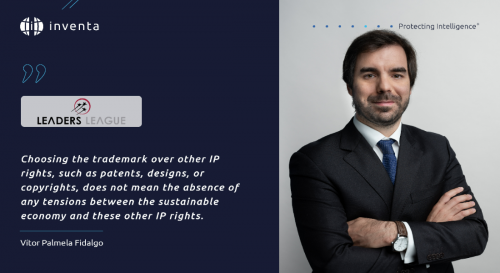
World IP Day 2023: Past, Present, and Future of Women in Intellectual Property
One of the most notable events for women in current affairs this year is undoubtedly the popular uprising in Iran. Uniting women and men from the country and around the world under the slogan "Woman, Life, Freedom," Iranian women have brought the issue of women's status at the center of the international community discussions.
Fighting against an authoritarian regime that limits their independence, Iranian women demand, among other things, the freedom to have control over their bodies and image, in a country where the registration of a trademark containing a woman's image is prohibited.
We praise the choice of the World Intellectual Property Organization (WIPO) to dedicate April 26, World Intellectual Property Day, to women.
This is an opportunity for us to celebrate all those who work towards fairer living conditions for women, and to reflect on how Intellectual Property (IP) can also contribute to this cause.
It is true that, currently, there is no longer a profound difference between men and women in democratic societies, thanks to feminist movements that began in the late 19th century in the United States and Europe. However, it is also true that gender inequality persists, to a greater or lesser extent, in all countries.
Let us take, for example, patent applications filed under the Patent Cooperation Treaty (PCT). We note that only about 16% of applications are from women, despite an increase in women participation in scientific fields.
As a reflection of society, IP shows us part of the reality of women at certain times and in certain contexts. As a driving force, and creator of reality, it has a crucial role to play in gender equality, particularly through the entities that represent it.
"Today, women's challenges are no longer so much about having their creations recognized by IP law. But they are still connected to the economic means at their disposal and the societal barriers directly associated with them."
Intellectual Property as a mirror of women reality
When invited to write about women and fiction in 1928, Virginia Woolf noted in A Room of One's Own that from the beginning of time until her era, there was a safe and prosperous sex and an insecure and poor one. The author adds that having sufficient economic means is a sine qua non condition for enjoying intellectual freedom and writing quality literature.
The freedom and quality of female authors, inventors, and innovators are effectively linked to the income they can obtain from their creations through, among other things, IP protection mechanisms. In order to achieve this, women must be given access to IP.
The fact still lingers in our memories that handicrafts such as embroidery, knitting, and quilting, created by women, were considered to have no economic value and were not marketable because they were produced within the domestic sphere. Furthermore, they were denied the requirement of "originality" because their creations were primarily intended to serve a functional purpose rather than being purely creative or artistic in nature. They were also denied author status but instead referred to as writers, as the author was the one who had authority. As Michel Foucault says, all authors are writers, but not all writers are authors. In all cases, the consequence was the same: women's creations were excluded from IP protection and relegated to the public domain.
Today, women's challenges are no longer so much about having their creations recognized by IP law. But they are still connected to the economic means at their disposal and the societal barriers directly associated with them.
Let us take again the example of patents. Protecting a patent involves a high financial effort, sometimes impossible for applicants to bear without bank support. Especially in developing countries, without financing, women lose access to IP, and their creations could enter the public domain.
As we have seen, only 16% of PCT patent applicants are women. Additionally, only 4% of patent applications in German-speaking countries identify women as inventors, 10% in the United States, and about 20% in several Spanish-speaking nations.
These numbers surprise us, as it is estimated that the vast majority of patents are held by applicants from countries in the Northern Hemisphere, where women received an education identical to that of men and have easier access to funding. So, how do we explain the low level of women applicants and inventors?
Ethnographic field studies show that there are social barriers that continue to prevent women from engaging with the patent system. For example, female scientists and engineers have less inclination than men to think about strategies for commercializing their inventions.
To women in the Northern Hemisphere, we recall the following words Virginia Woolf wrote in 1928: "When you reflect upon these immense privileges and the length of time during which they have been enjoyed, and the fact that there must be at this moment some thousand women capable of earning over five hundred a year in one way or another, you will agree that the excuse of lack of opportunity, training, encouragement, leisure and money no longer holds good".
"Women have achieved many successes in the last century. We see them governing powerful countries, leading regional and international organizations, and running multinational corporations. They are award-winning authors and great artists. Esteemed philosophers and scientists."
Intellectual Property as a Driving Force for Gender Equality
There are at least two types of influences of IP on the condition of women: at the level of the adoption of IP legislation and at the level of IP entities, namely WIPO and National IP Institutes.
Therefore, it is essential to consider the impact of IP laws on the most vulnerable groups when adopting IP legislation. For example, it has been argued by Sharmishta Barwa and Shirin M. Rai [1] that some apparently neutral measures of the Trade-Related Aspects of Intellectual Property Rights (TRIPS) agreement have negative impacts on women. As an illustration, the possibility of protecting processes by patent rights prevented women farmers from keeping the seeds of their crops, which limits them in their profession.
On the other hand, several feminist IP scholars have examined IP law in the United States from the perspective of women's interests and found that, like many areas of law, IP laws have gender aspects. Therefore, studying and deconstructing IP law seems relevant to understanding and eliminating gender inequalities in legislation.
Regarding IP entities, such as WIPO and national IP institutes, it is essential that they address and act towards gender parity.
Gender equality is one of WIPO's main concerns. Through the adoption of its Gender Equality Policy in 2014, it defined gender equality as a cross-cutting objective in its work. Specifically, WIPO is introducing a range of mentoring programs focused on intellectual property in different regions of the world. These programs provide guidance, knowledge, and resources to support women-led businesses. It emphasizes the importance of education and provides free IP courses, including distance learning programs. It also encourages representatives of member states in their meetings to implement actions that support women. WIPO is also preparing a Gender and IP Action Plan, which will be published soon.
At the national level, many national IP institutes show the same concern and are implementing various initiatives with the aim of allowing women to participate in the IP system.
Some examples include the Intellectual Property Office of the Philippines (IPOPHL) through the implementation of the Juana Patent and Juana Design Protection Incentive Program (JPIP) which helps women inventors and designers protect and enjoy their IP rights. The Office of the Controller General of Patents, Designs, and Trade Marks (CGPDTM) in India offers an 80% reduction in fees for women-led startups and entrepreneurs. The Pro Bono Program of the United States Patent and Trademark Office (USPTO) provides free legal assistance to inventors and small businesses, many of which are led by women. Finally, the Mexican Institute of Industrial Property (IMPI) through its Mujeres Innovadoras program offers women a variety of resources, including training, mentoring, and workshops.
Women have achieved many successes in the last century. We see them governing powerful countries, leading regional and international organizations, and running multinational corporations. They are award-winning authors and great artists. Esteemed philosophers and scientists. We believe that these successes will continue and that with the support of IP, they will gradually extend to encompass all women, with the objective of fostering more equitable, prosperous, and intellectually liberated societies.
[1] Rai, Shirin and Barwa, Sharmishta (2002) The political economy of intellectual property rights: a gender perspective. In: Newell, Peter and Rai, Shirin and Scott, Andrew, (eds.) Development and the challenge of globalization. London : ITDG Publishing, pp. 41-56. ISBN 1853394920
Lista de Territórios
Não existem resultados para a sua pesquisa.
- África
- África do Sul
- Angola
- Argélia
- Benin
- Botsuana
- Burkina Faso
- Burundi
- Cabo Verde
- Camarões
- Chade
- Comores
- Costa do Marfim
- Djibuti
- Egito
- Eritreia
- Eswatini (Suazilândia)
- Etiópia
- Gabão
- Gâmbia
- Gana
- Guiné
- Guiné-Bissau
- Guiné-Equatorial
- Lesoto
- Libéria
- Libia
- Madagáscar
- Maiote
- Malaui
- Máli
- Marrocos
- Maurícias
- Mauritânia
- Moçambique
- Namíbia
- Níger
- Nigéria
- Quénia
- República Centro-Africana
- República Democrática do Congo
- República do Congo
- Reunião
- Ruanda
- Saara Ocidental
- São Tomé e Principe
- Seicheles
- Senegal
- Serra Leoa
- Somália
- Sudão
- Sudão do Sul
- Tanzânia
- Togo
- Tunísia
- Uganda
- Zâmbia
- Zanzibar
- Zimbábue
- África (OAPI)
- África (ARIPO)
- Mais Territórios
- Macau
- Maldivas
- Portugal
- Timor Leste
- Marca da União Europeia (EUIPO)
- Marca Internacional (Sistema de Madrid)
- Patente Europeia (IEP)
- Tratado de Cooperação em matéria de Patentes (PCT)




